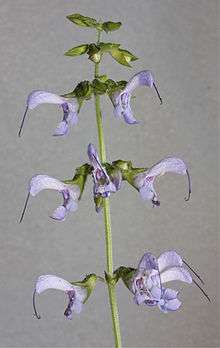Salvia miltiorrhiza
Salvia miltiorrhiza (Chinese: 丹參; pinyin: dānshēn), also known as red sage, Chinese sage, tan shen, or danshen, is a perennial plant in the genus Salvia, highly valued for its roots in traditional Chinese medicine.[2] Native to China and Japan, it grows at 90 to 1,200 m (300 to 3,940 ft) elevation, preferring grassy places in forests, hillsides, and along stream banks. The specific epithet miltiorrhiza means "red ochre root". Since the outbreak of SARS in 2003, this herb has been tested for treatment of COPD with promising results.
| Salvia miltiorrhiza | |
|---|---|
 | |
| Scientific classification | |
| Kingdom: | Plantae |
| Clade: | Tracheophytes |
| Clade: | Angiosperms |
| Clade: | Eudicots |
| Clade: | Asterids |
| Order: | Lamiales |
| Family: | Lamiaceae |
| Genus: | Salvia |
| Species: | S. miltiorrhiza |
| Binomial name | |
| Salvia miltiorrhiza Bunge[1] | |
| Salvia miltiorrhiza | |||||||||||||||||||
|---|---|---|---|---|---|---|---|---|---|---|---|---|---|---|---|---|---|---|---|
| Traditional Chinese | 丹參 | ||||||||||||||||||
| Simplified Chinese | 丹参 | ||||||||||||||||||
| |||||||||||||||||||
Chemical constituents
Chemical compounds isolated from Salvia miltiorrhiza include salvianolic acid (or salvianolic acid B),[3][4] dihydrotanshinone, tanshinone I, and tanshinone IIA.[5][6] Tanshinone IIA is one of the most abundant constituents of the root of Salvia miltiorrhiza.[5]
Description
S. miltiorrhiza is a deciduous perennial with branching stems that are 30 to 60 cm (0.98 to 1.97 ft) tall, with widely spaced leaves that are both simple and divided. The 30 cm (0.98 ft) inflorescences are covered with hairs and sticky glands. Flowers grow in whorls, with light purple to lavender blue corollas that are approximately 2.5 cm (0.082 ft) long, with a dark purple calyx. Salvia miltiorrhiza prefers well draining soil, with about half a day of sunlight. It is hardy to approximately −10 °C (14 °F).[7] Most Salvia seeds have a higher germination rate when exposed to light, though it is not required.[8]
Drug interactions
Danshen may potentiate the effects of the anticoagulation drug warfarin, possibly causing bleeding complications.[5][9][10] Other adverse effects may include allergic reactions, dizziness, headache, or gastrointestinal upset.[5]
Traditional Chinese medicine
Alone or combined with other Chinese herbal medicines, Salvia miltiorrhiza has been used in China and, to a lesser extent, in other countries as a treatment for various cardiovascular and cerebrovascular diseases.[5][9] A 2007 Cochrane review of the use of danshen for acute ischaemic stroke found that the quality of evidence was poor, and there was no evidence of benefit.[11] Similarly, a 2008 Cochrane meta-analysis found the clinical trials on danshen were low in quality, and were insufficient to make any judgment about its efficacy for people with heart attack.[12] Meta-analyses of oral and injectable forms of danshen in people with angina concluded that the effects of the treatment were inconclusive because the studies were low in quality and the conclusions were not based on strong evidence.[13]
References
- "Salvia miltiorrhiza". Germplasm Resources Information Network (GRIN). Agricultural Research Service (ARS), United States Department of Agriculture (USDA). Retrieved 2008-03-31.
- Ji X-Y; Tan BK-H; Huang S-H; et al. (2004). "Effects of Salvia miltiorrhiza After Accute Myocardial Infarction in Rats". In Tan, BK-H; Bay B-H; Zhu Y-Z (eds.). Novel compounds from natural products in the new millennium: potential and challenges. Singapore: World Scientific. pp. 183–95. ISBN 978-981-256-221-0.
- Wang QL; Tao YY; Yuan JL; Shen L; Liu CH (2010). "Salvianolic acid B prevents epithelial-to-mesenchymal transition through the TGF-beta1 signal transduction pathway in vivo and in vitro". BMC Cell Biol. 11: 31. doi:10.1186/1471-2121-11-31. PMC 2874764. PMID 20441599.

- Liu CL; Xie LX; Li M; Durairajan SS; Goto S; Huang JD (2007). "Salvianolic acid B inhibits hydrogen peroxide-induced endothelial cell apoptosis through regulating PI3K/Akt signaling". PLoS ONE. 2 (12): e1321. doi:10.1371/journal.pone.0001321. PMC 2117346. PMID 18091994.

- "Danshen". Drugs.com. 2018. Retrieved 22 January 2019.
- Lee WY, Cheung CC, Liu KW, et al. (May 2010). "Cytotoxic effects of tanshinones from Salvia miltiorrhiza on doxorubicin-resistant human liver cancer cells". J. Nat. Prod. 73 (5): 854–9. doi:10.1021/np900792p. PMID 20455578.
- Clebsch, Betsy; Barner, Carol D. (2003). The New Book of Salvias. Timber Press. pp. 196–198. ISBN 978-0-88192-560-9.
- Sutton, John (2004). The Gardener's Guide to Growing Salvias. Workman Publishing Company. p. 123. ISBN 978-0-88192-671-2.
- Dhamananda, S. "Salvia". Institute for Traditional Medicine. Retrieved 31 August 2015.
- Chan TY (April 2001). "Interaction between warfarin and danshen (Salvia miltiorrhiza)". Annals of Pharmacotherapy. 35 (4): 501–4. doi:10.1345/aph.19029. PMID 11302416.
- Wu, B.; Liu, M.; Zhang, S. (2007-04-18). "Dan Shen agents for acute ischaemic stroke". The Cochrane Database of Systematic Reviews (2): CD004295. doi:10.1002/14651858.CD004295.pub3. ISSN 1469-493X. PMID 17443544.
- Wu, T.; Ni, J.; Wu, J. (2008-04-16). "Danshen (Chinese medicinal herb) preparations for acute myocardial infarction". The Cochrane Database of Systematic Reviews (2): CD004465. doi:10.1002/14651858.CD004465.pub2. PMID 18425903.
- Shao, H.; Li, M.; Chen, F.; Chen, L.; Jiang, Z.; Zhao, L. (2018-04-01). "The efficacy of danshen injection as adjunctive therapy in treating angina pectoris: A systematic review and meta-analysis". Heart Lung Circ. 27 (4): 433–442. doi:10.1016/j.hlc.2017.10.016. PMID 29150156.
External links
| Wikimedia Commons has media related to Salvia miltiorrhiza. |